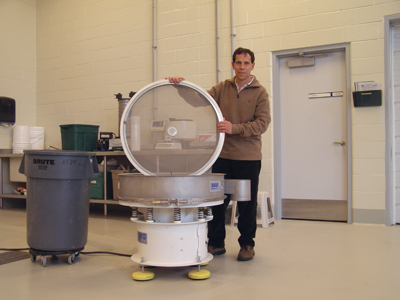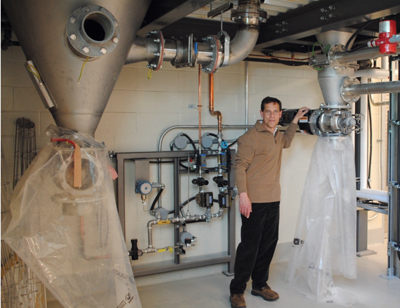
Novel Fractionation for DDGS
By Treena Hein
Features New Technology ProductionAlberta researcher has developed a process that allows wheat DDGS to be a realistic and competitive
It’s well known that distiller’s dried grain with solubles (DDGS), the
main co-product of ethanol manufacture, is used as animal feed. DDGS
has higher, more concentrated, levels of most nutrients in comparison
to the native grain used to produce the ethanol. For example, the
protein content in wheat DDGS is about three times that found in wheat
grain, or about 38 to 40 per cent of dry weight.
It’s well known that distiller’s dried grain with solubles (DDGS), the main co-product of ethanol manufacture, is used as animal feed. DDGS has higher, more concentrated, levels of most nutrients in comparison to the native grain used to produce the ethanol. For example, the protein content in wheat DDGS is about three times that found in wheat grain, or about 38 to 40 per cent of dry weight.
 |
|
| Improving DDGS Value Eduardo Beltranena has developed a method to increase the feeding value of DDGS by separating it into fractions using sieves and then further separating it by weight. Advertisement
|
Sounds fantastic, but there’s a catch: the fibre level of wheat DDGS is also three times that of wheat grain (about 35 per cent). “This limits its nutrient utilization by monogastric animals such as chickens, which don’t have a rumen full of bacteria to digest fibre like cattle do,” says Eduardo Beltranena, a feed research scientist with Alberta Agriculture and Rural Development.
This fact inspired Beltranena and his team to develop a process to separate DDGS into fractions suitable for feeding to different types of animals – a low cost, environmentally friendly way of enriching the protein and reducing the fibre, allowing part of the DDGS to be fed to poultry, hogs and trout. “We aimed to make DDGS a realistic and competitive alternative to more costly protein supplements, for example, soybean meal in poultry rations, and we’ve succeeded,” he says. “We’ve provided the ethanol industry with a step they can add at the end of their processing to improve the value of this ample ethanol co-product, diversifying the market opportunity for DDGS well beyond cattle feed.”
The process is fairly simple, but let’s back up a moment and look at how DDGS is produced. The precursor to DDGS is the mixture of the solid and soluble residues left over from the fermentation and distillation process (where starch in the grain is converted into ethanol). This mixture is separated into liquid solubles and a solid “wetcake” fraction. The solubles are heated and excess liquid is evaporated to produce concentrated syrup. This is then added back into the wetcake and the mixture is dried.
 |
The first step in Beltranena’s process involves putting the DDGS through sieves. “The smaller particles that pass through the sieves are almost 50 per cent protein and only 18 per cent fibre, excellent feed for broiler chicks zero to 21 days old,” Beltranena notes. What is caught by the top sieve is then placed in another machine that separates the particles by weight. “The next fraction obtained is also high in protein and low in fibre, very good for broiler chicks 21-42 days old and laying hens of all ages,” says Beltranena. “The two remaining ‘ruminant’ fractions, which have 35 and 29 per cent protein and 32 and 37 per cent fibre respectively, are highly suitable for dairy and feedlot cattle.”
However, no matter how good the results of the DDGS fractionation process, unless it’s cost-effective and easy to implement, ethanol plants will not incorporate it. “That’s why we envisioned from the start a process that can be easily added on to existing ethanol plant setups,” Beltranena says. “These ethanol plants have obviously already been built and it is unlikely it would be feasible at any of them to modify the existing processes in order to improve the quality of a lesser important co-product compared to ethanol.” Therefore, he says, readily available particle size and weight separation equipment was chosen for testing, equipment that could serve as a back end add-on. “Adding this step at the plant is something that can be done quickly, and it would provide an immediate and rapid benefit,” says Beltranena. “It’s a very modest investment that would provide quick and big returns to both the ethanol and animal industries.”
While the cost return for the equipment and small additional energy inputs for the proposed back end processing would vary with each ethanol plant, Beltranena speculates that using the process will bring an additional $10-$20 for every metric tonne of DDGS produced, and therefore, “the initial and ongoing costs could quickly be recouped.”
Although news of the novel fractionation process has just been released, Beltranena has already had calls of interest from ethanol consultants in both Canada and the United States.
There are currently 16 ethanol plants in Canada. Corn grain is mainly used to make the fuel at the plants located in central Canada and wheat grain is used on the Prairies. “This is groundbreaking in that no one else is looking into how to boost the value of wheat DDGS,” Beltranena says. “No one has looked into fractionating wheat DDGS because it’s not worth as much as corn DDGS.” However, while DDGS from corn is valuable because of its high oil content, once that is squeezed out, corn DDGS has a lower feed energy value and protein content than that of wheat DDGS.
Feeding trials with broilers, trout and growing pigs using the four wheat DDGS fractions have just begun in collaboration with scientists at the Universities of Saskatchewan and Alberta. “We will first determine the extent of improvement in nutrient digestibility prior to growth validation animal trials,” says Beltranena. “We are excited about the potential for positive results because the reduction in DDGS fibre content for monogastric animals is substantial.”
Print this page